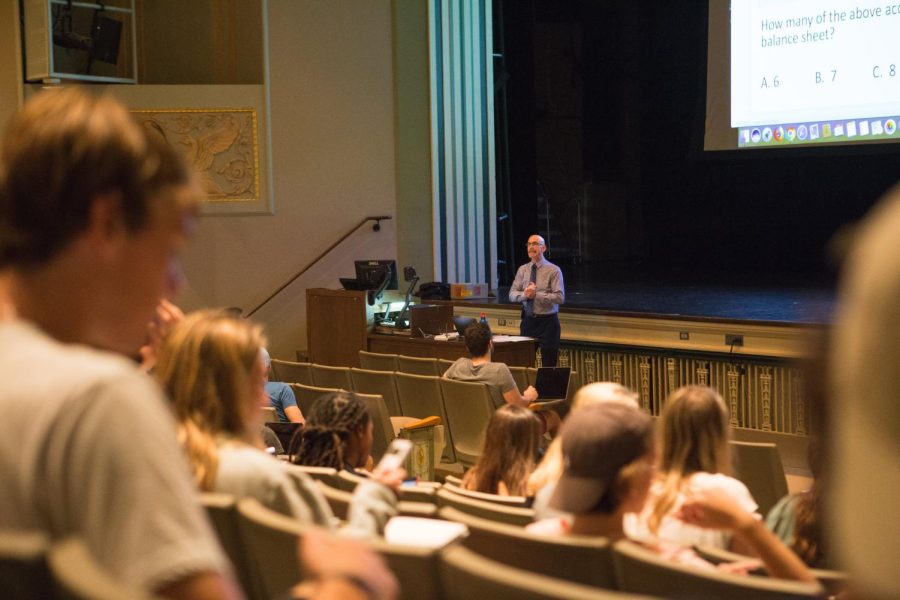Students reflect on learning styles after remote start to semester
Professor Mitch Fisher lectures to his ACCY 201 class at Lincoln Hall Theater on Aug. 29, 2019. Students talk about how their learning styles are impacted from remote versus in-person learning.
Jan 25, 2022
Last updated on Dec. 28, 2022 at 10:28 a.m.
On Monday, underneath an overcast sky and amid the harsh central Illinois winter, students began their first spring semester in person since 2020. They headed to their morning classes bundled up and trudging through the light dusting of snow to attend the first in-person classes of the semester – last week, the first week of the semester, was remote to allow for students to get tested.
A lot has changed since 2020 – a worldwide pandemic, a presidential election and the rise and fall of Quibi – but the initial week of remote classes gave some students an unwelcome reminder of the past year of online learning.
Rudra Patel, junior in Business, said he initially liked the novelty of remote learning but quickly wanted to return to the classroom.
“At the beginning, the online thing was kind of cool and it was nice because I was able to do a lot more since everything was online, but now I’m kind of ending my college career, I really want to do it in person,” Patel said. “I want to meet new people, and I feel like I learn a lot better in person.”
Get The Daily Illini in your inbox!
Despite vastly preferring to learn in person than remotely, he recognized the benefits the week of remote learning provided. Patel himself used the week of remote classes to drive home and get a booster shot before returning back to campus for in-person learning.
“The first class is important, but it’s a pretty basic class where it’s just a syllabus or schedule overview, you don’t really get into the important stuff too early,” Patel said. “It’s kind of nice being given that remote option, it allowed for people to be more flexible to travel back and forth like I needed to. Overall, I think it was a good idea because no one has an excuse not to get tested at this point.”
For most students who expressed their opinions, in-person learning is vastly more efficacious than remote learning. For Alexander Carmona, sophomore in LAS, face-to-face feedback serves a strong purpose in pursuit of his creative writing degree.
“I prefer to have classes in person because there’s more energy, and I feel like I understand the topics better if someone says it to my face,” Carmona said. “It’s better getting feedback face-to-face instead of through a screen.”
Cramming into a tightly-packed lecture hall can be uncomfortable: tracked snow caked into the carpet, bulky winter coats strewn on the back of seats and a few scattered coughs as people recover from the flu season. All this, coupled with getting situated to a new course with a new professor can be unideal. Some students found that remote classes eliminated the subtle annoyances associated with large lectures during the winter.
Ansh Rana, sophomore in Engineering, noted that while he prefers in-person classes for smaller discussions and labs, lectures are better suited for an online format.
“I realized this past week that lectures are much more easily transmittable through online situations, especially when you have these huge lecture halls,” Rana said.
He explained that certain aspects of the classroom are easier to grasp in an online environment. However, Rana still sees issues with them.
“It’s almost better because you can hear the professor, you see exactly where he’s working, and so on. But for smaller classes on Zoom, no one really talks, everyone has their camera off so you’re just kind of independently doing everything, and I don’t think remote works so well for discussions and labs,” he said.
Because his freshman year was completely onlie, Rana despises remote learning. However, the previous week of remote learning gave him a new appreciation for the alternative learning environment.
“Last year, I was just so totally done with remote learning,” Rana said. “Coming back online this week kind of gave me a different view where I’m not so totally against online, and I have a more nuanced view of it where I can recognize how sometimes it’s beneficial.”
One benefit of remote learning Rana noted was its safety. While Rana was not too worried about the Omicron variant affecting his personal health, he recognized that some people will feel safer if the University continues to offer a remote option.
“I have the view that I’m fine with doing everything in person, but I know there’s plenty of people who don’t share that view, and rightly so, they have different circumstances than me,” Rana said. “I think it’s really good for the University to allow hybrid options so those who do have extenuating circumstances and do not feel comfortable can still succeed and take online classes.”
Most professors continue to offer a remote option for students, especially as COVID-19 cases remain high. On Sunday – the latest data available from the University’s Shield testing data dashboard –, 202 individuals tested positive. The seven-day average positivity rate sits at 3.44%.
Compared to the same date last year, only 20 individuals tested positive for a 0.27% positivity rate.






